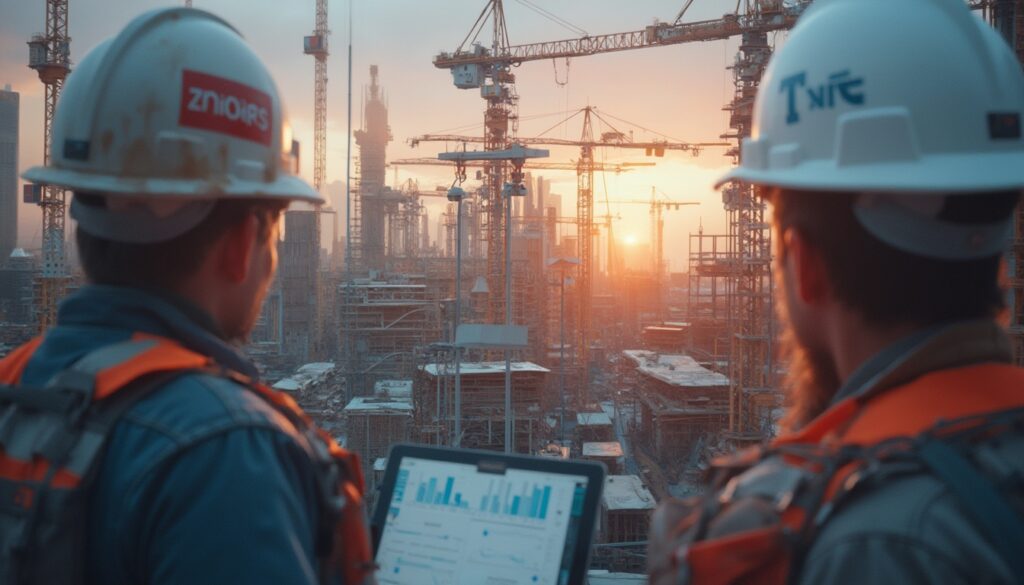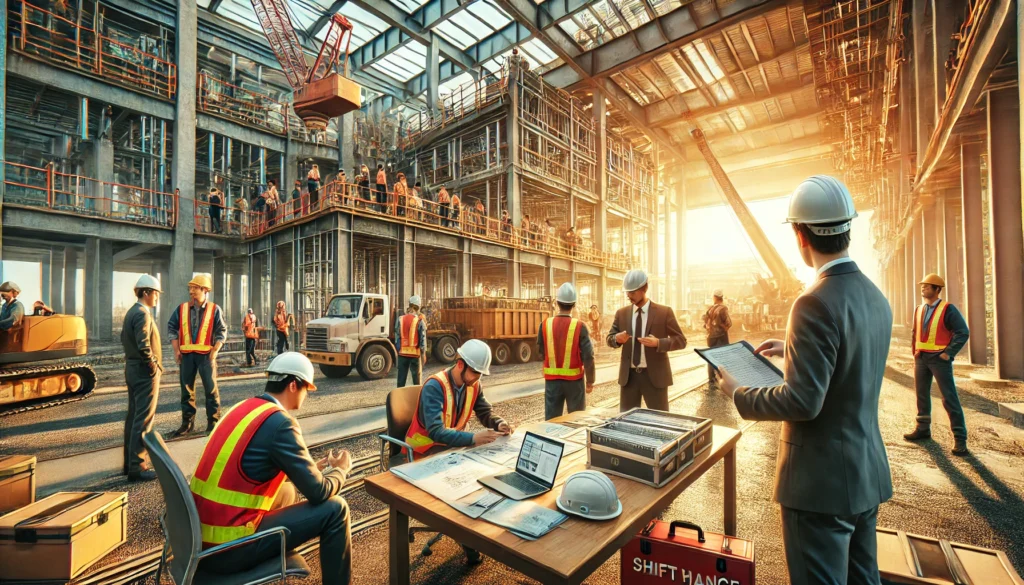Current salary data for the construction industry 2024
The average gross annual salary in the construction industry is 52,134 euros in 2024. When considering the entire construction sector, which also includes planning and engineering services, the average rises to around 60,504 euros per year. Recent collective bargaining negotiations in the main construction sector have led to noticeable increases. Since May 1, 2024, employees receive an additional flat rate of 230 euros per month, in addition to a percentage increase of 1.2% in West Germany and 2.2% in East Germany. Despite a tense economy, earnings in both building construction and civil engineering rose by 9.6% until April 2024, highlighting the ongoing pressure from the skilled labor shortage. Nevertheless, average earnings in construction are still around 8% lower than those in the manufacturing sector. Closing this gap is a central task for the industry’s competitiveness. The solution lies in increasing productivity to create financial leeway. The new collective agreement, valid for 36 months until March 31, 2027, sets a clear direction. The gradual alignment of Eastern to Western pay scales by 2026 will further intensify competition.
Top earners: Which positions lead the salary ranking?
The salary range within the construction industry is significant and heavily depends on the respective position and responsibility. At the top of the salary table are positions with high responsibility for budget and personnel. A construction manager can expect an annual salary of around 90,000 euros as they are responsible for coordinating and ensuring smooth operations on the construction site. Close behind are project managers with around 77,500 euros who oversee projects from conception to completion. Architects and civil engineers are also positioned in the upper segment. The median salary for a civil engineer is about 59,200 euros but can rise to over 75,900 euros with more than 10 years of experience. Particularly, personnel responsibility has a strong impact: An experienced civil engineer with management tasks earns an average of 83,900 euros. These figures show that specialization and taking on responsibility directly reflect in the salary on the construction site. To justify such salaries, the processes behind these roles must be highly efficient. A construction manager who spends their time searching for information instead of managing the project costs the company double.
Factors influencing salary: experience, location, and specialization
In addition to position, three other factors significantly determine salaries in the construction industry. Professional experience is the most important lever for higher income. While the starting salary for civil engineers is around 49,600 euros, colleagues with more than ten years of experience earn an average of 75,900 euros – an increase of over 50%. The second factor is location. There is still a noticeable East-West pay gap. A civil engineer in West Germany earns around 5,400 euros per month, while in East Germany it is 4,660 euros. Leading federal states such as Hesse and Baden-Württemberg have average salaries of over 62,500 euros for civil engineers. Thirdly, specialization pays off. Whether in sustainable construction, civil engineering, or as a construction coordinator – expert knowledge is compensated above average. These factors highlight how important targeted personnel development is to counter the skilled labor shortage in the construction industry. To counteract it.
The connection between process efficiency and salary range
Every inefficient hour on the construction site reduces margins and thus the room for higher salaries. Communication chaos via unstructured WhatsApp groups leads to errors that account for an average of 5% of construction costs. Missing or incomplete construction daily reports cause a high manual follow-up effort of several hours per week. This is exactly where Valoon comes in by digitizing and automating communication and documentation directly on the construction site. Imagine you could reduce the effort for construction site documentation by 30%. This saved time can allow your construction and project managers to focus on their core tasks: managing the project and ensuring quality. Reducing errors and accelerating processes create financial leeway. You can use this to compete for the best career changers for the construction industry with a more attractive salary package.
How Valoon lays the foundation for better compensation
Higher productivity is the key to better salaries. Valoon boosts this productivity through simple yet effective tools integrated directly into WhatsApp. This means zero training effort for your team on the construction site. Here are concrete examples of how Valoon creates financial leeway:
- Automated daily construction reports: Photos, notes, and events are captured directly from the construction site via WhatsApp and automatically compiled into a legally compliant daily report. This saves up to 60 minutes per construction manager daily.
- Legally compliant photographic documentation: All images automatically receive a timestamp and location stamp and are archived project-specific. This reduces liability risks and costs for defect rectification by up to 20%.
- Digital timesheets: Employees easily record their working hours via message. The data is immediately available to the office, speeding up payroll processing by up to 75%.
- Live translation: Language barriers are overcome directly in WhatsApp. This avoids misunderstandings that lead to costly rework – a common problem in international teams.
These efficiency gains improve the profitability of each individual project and enable you to actively shape salaries in the construction industry rather than merely reacting to collective agreements.
Conclusion: Invest in efficiency to win the salary competition
An attractive salary in the construction industry is more than just a number on paper – it’s a sign of appreciation and a crucial factor for the future of the construction industry.. Current collective increases are just the beginning. To sustainably attract and retain the best talents, companies must operate profitably and efficiently. Valoon provides the simplest solution to immediately increase productivity on the construction site and in the office. By automating documentation, simplifying communication, and reducing errors, you create the financial basis for competitive compensation. Don’t wait until the best employees leave you. Act now and invest in the efficiency of your processes. Book your free demo and discover how Valoon can make your business ready for the future in just 30 minutes.
More Links
IFO provides insights into the business climate index for the main construction sector, reflecting the current mood and expectations of the construction industry.
German Institute for Economic Research (DIW) provides a weekly report on the current state of the construction industry in Germany.
Federal Ministry for Economic Affairs and Climate Action (BMWK) offers a dossier on the topic of digitization which may also be relevant for the construction industry.
FAQ
How can I as a construction company pay higher salaries?
The key lies in increasing efficiency. By digitizing processes such as construction documentation, time tracking, and defect management with Valoon, you reduce administrative effort, minimize costly mistakes, and increase productivity. The costs saved can be directly invested into more attractive salaries for your employees.
What influence does the location have on salaries in construction?
Location has a significant impact. There is a noticeable salary gap between West and East Germany, with western federal states like Hesse and Baden-Württemberg generally offering the highest pay. However, by 2026, the collective wages between East and West are expected to be fully aligned.
How much does a civil engineer earn upon entering the profession?
The starting salary for a civil engineer in Germany is on average around 49,600 euros gross per year. This salary can vary based on company size, location, and the specific area of responsibility.
Is personnel responsibility financially worth it in the construction industry?
Yes, definitely. Taking on personnel responsibility is one of the greatest salary drivers. A civil engineer with over 10 years of experience and management responsibilities earns around 83,900 euros, almost 20% more than a colleague in a purely technical position (approx. 70,300 euros).
How does Valoon help combat the skilled labor shortage?
Valoon helps in two ways: First, it increases efficiency, which frees up financial resources for higher salaries and makes you a more attractive employer. Second, it simplifies work on the construction site through intuitive usage via WhatsApp and live translation, significantly easing the onboarding process for new employees, including international professionals and career changers.
Is using Valoon complicated for employees on the construction site?
No, not at all. This is the core advantage of Valoon. Your employees on the construction site continue to use WhatsApp as usual. No new app needs to be installed or learned. This ensures 100% acceptance from day one and requires zero training effort.








